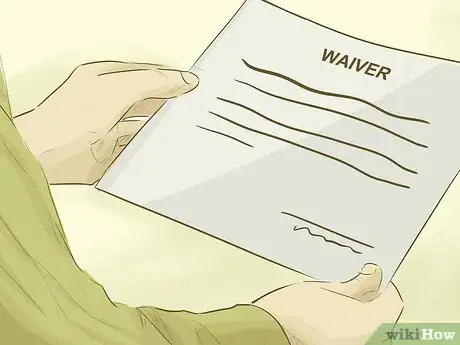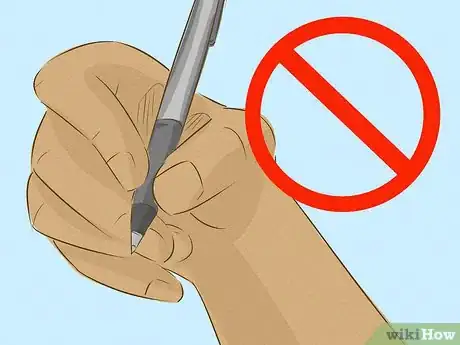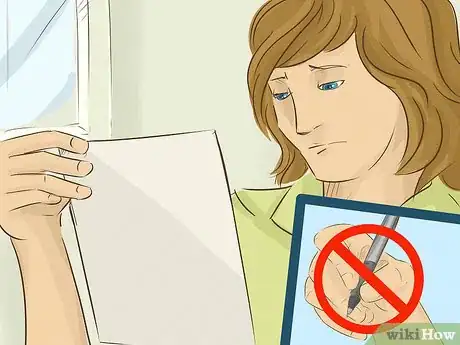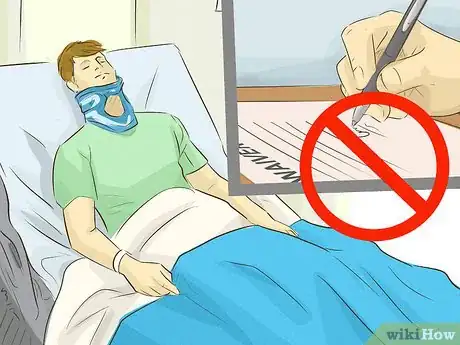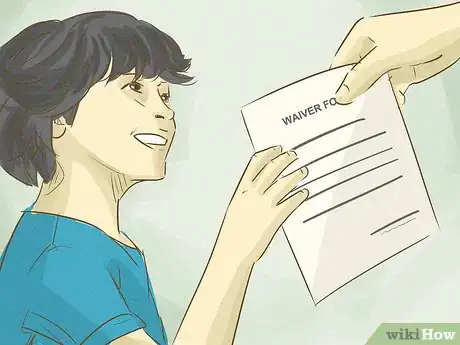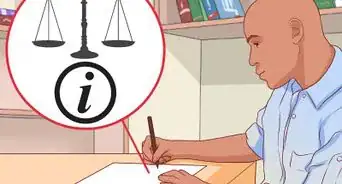X
This article was co-authored by Clinton M. Sandvick, JD, PhD. Clinton M. Sandvick worked as a civil litigator in California for over 7 years. He received his JD from the University of Wisconsin-Madison in 1998 and his PhD in American History from the University of Oregon in 2013.
This article has been viewed 26,802 times.
When a business asks you to sign a waiver of liability, it is trying to avoid paying you compensation if you are injured. Waivers are used by ski resorts, high school athletic programs, and a host of other businesses and organizations. Before signing the waiver, you need to understand its terms and why the organization wants you to sign it.
Steps
Method 1
Method 1 of 3:
Signing the Liability Waiver
-
1Sign the waiver if it is required to participate. Some organizations might not let you participate unless you sign a waiver of liability. In this situation, you face a choice: sign the waiver and participate or don’t sign the waiver and be prevented from participating.
- Only you can make the choice. If you want to participate in the activity badly enough, then you should sign the waiver.
-
2Read the waiver before signing. You should always read any waiver given to you to sign. Before deciding whether to sign it, you need to understand its purpose and what rights you are giving up. You should only sign a waiver if you agree and understand each of its provisions. Take out your waiver and look for the following common waiver provisions:
- To relieve the organization of liability for your injury. The waiver might state that you agree to “hold harmless” the organization. Basically, the organization is trying to prevent you from suing it for your injuries.
- To limit where you can bring the lawsuit. A waiver of liability might try to get you to agree to bring your lawsuit in only a certain court. The purpose of this provision is to protect the organization from having to go to a distant part of the country to defend itself.
- To force you to arbitrate an injury. Arbitration is a form of dispute resolution which is private. Instead of going to court, you agree to present your case to a private arbitrator. Some organizations might try to get you to agree to arbitrate any dispute that you have.
Advertisement -
3Try to negotiate. You should ask if you can negotiate some of the terms of the waiver. You probably won’t be successful.[1] Nevertheless, you should feel free to ask, particularly if there is only one provision you disagree with.
- You could say, “I know you probably don’t negotiate these waivers, but would it be possible to remove the arbitration provision?” If the company agrees, then you and a manager can both initial the pages that are being changed and write in the revision.
- If the business says no, then you are probably stuck either signing it or not participating in the activity.
-
4Show your lawyer the waiver. If you are unsure about signing the waiver, then a lawyer’s advice would be most helpful.[2] A lawyer can review the waiver and make sure that you are not signing away valuable rights. A lawyer could also try to negotiate with the company on your behalf.
- For everyday activities, like skiing or visiting an amusement park, you probably don’t have time to show the waiver to an attorney.
- However, if you are signing a waiver related to an employment contract, then you should have enough time to review it with a lawyer.
-
5Keep a copy of the liability waiver. In the event you are injured, you will want to know precisely what the waiver said. After signing the waiver, ask the organization if you can have a copy.
- Store it in a safe place at home, where you know that you can find it.
Advertisement
Method 2
Method 2 of 3:
Refusing to Sign the Liability Waiver
-
1Don’t sign if the waiver isn’t required to participate. Before signing, you should ask if you need to sign. Some activities might require that you sign the waiver before you can participate. In a school setting, you might have to sign a waiver of liability as a parent in order for the school to let your child participate in an activity, such as sports or a field trip.
- If you don’t have to sign, then there is no reason to sign a waiver.[3] Maybe the organization has made the waiver optional. In this situation, you don’t need to sign.
- Ask whoever is in charge if you have to sign the waiver and why.
-
2Refuse to sign if you don’t understand the waiver. Since a waiver is a contract, you shouldn’t sign if you don’t understand the document. You don’t want to agree to a document unless you understand its terms.
- Take your time reading the waiver and don’t feel rushed. It is illegal for the organization to try and coerce you into signing the waiver of liability.
- If you don’t understand something, then ask for clarification. If the organization does not clarify what the language means, then don’t sign the waiver.
- Also don’t assume that all waivers are the same. The fact that you signed a waiver last year when your daughter joined the swim club does not mean that the skiing club’s waiver is the same. Always read the waiver.
-
3Avoid signing a waiver after an accident. If you or your child is injured, then you should not sign any kind of waiver or document. A company or insurer might shove a bunch of papers in front of you and ask for your signature. Among these papers could be a release from liability.[4]
- Waivers should only be signed before participating in an activity, not after you are hurt. Do not sign any company or insurance documents after the injury.
- If you are injured and given papers to sign, immediately call a personal injury attorney. An attorney can advise you about your rights.
- You can find a personal injury lawyer by contacting your state or local bar association. These organizations of attorneys should have referral programs.
-
4Refuse to be pressured into signing. You might be gently told not to worry about the waiver or that you should sign it because “everything will be okay.” You should politely resist these efforts to pressure you.
- For example, you could say, “I’m sure it’ll be okay, but I don’t think I need to sign it right now.”
- Or you could say, “My lawyer will probably agree everything is fine. But I want to show her the document before signing it.”
Advertisement
Method 3
Method 3 of 3:
Understanding the Consequences of Signing the Waiver
-
1Research your state law on liability waivers. Your state law determines whether a waiver is valid. Accordingly, you will need to research your state’s law on when a court will enforce a waiver of liability.
- In North Carolina, for example, a waiver is generally enforceable. However, it will not be enforced if the company intentionally injured you or consciously disregarded a danger.
- North Carolina also will not enforce a waiver if you signed it because of fraud or coercion.[5]
- Other states are more hostile to waivers of liability than North Carolina. Louisiana, Montana, and Virginia all refuse to enforce waivers of liability.[6]
- It may be difficult to find out the status of your state law. Court opinions are not easy to find. You can search the Internet for summaries of your state’s law. Alternately, you could meet with a lawyer, who can inform you of the current status of your law.
-
2Understand that a minor can void a waiver. If your child signed a waiver of liability, then he or she can generally cancel the waiver because minors cannot contract. In most states, someone younger than 18 is a minor who cannot form a valid contract.
- In most states, parents also can’t waive their child’s negligence claim. Accordingly, even if an adult signs the waiver, the minor can cancel it anyway.
-
3Consult an attorney if you are injured. Only a lawyer can advise you properly about whether you can sue someone if you signed a waiver. State law often changes, and you want the most up-to-date information.
- You shouldn’t assume that because you signed a waiver you’ll never be able to get money from the company that injured you. A skilled attorney can make the case that your injury falls outside the coverage of the waiver.
Advertisement
References
- ↑ http://www.injuryclaimcoach.com/gym-insurance-claims.html
- ↑ http://www.injuryclaimcoach.com/gym-insurance-claims.html
- ↑ http://blogs.findlaw.com/injured/2015/08/are-you-required-to-sign-school-liability-waivers.html
- ↑ http://www.2keller.com/library/should-i-sign-a-release-or-authorization-after-my-accident-.cfm
- ↑ http://www.minicklaw.com/i-signed-a-liability-release-waiver-can-i-still-sue/
- ↑ http://recreation-law.com/2010/12/16/states-that-do-not-support-the-use-of-a-release-3/
About This Article
Advertisement

